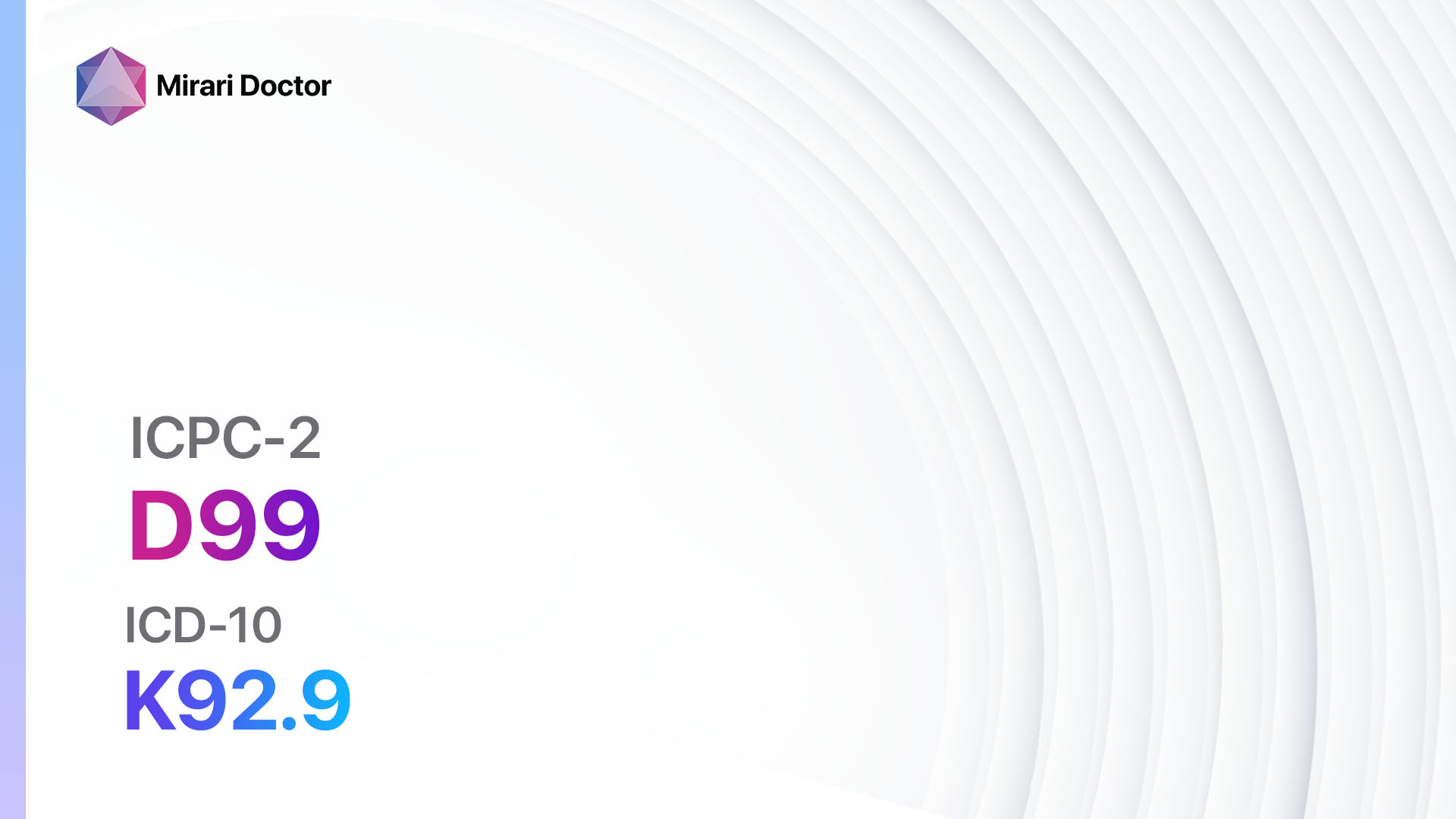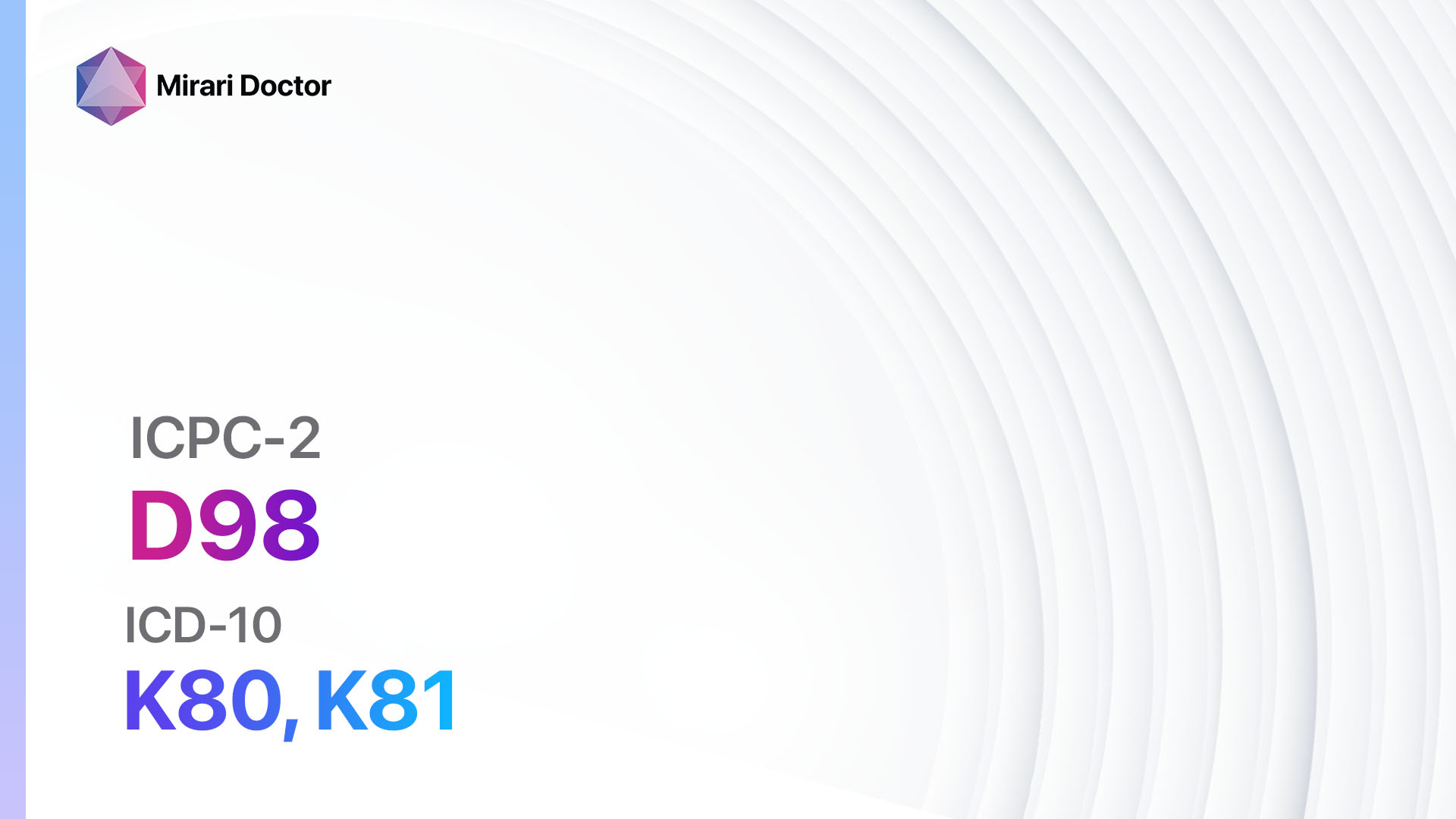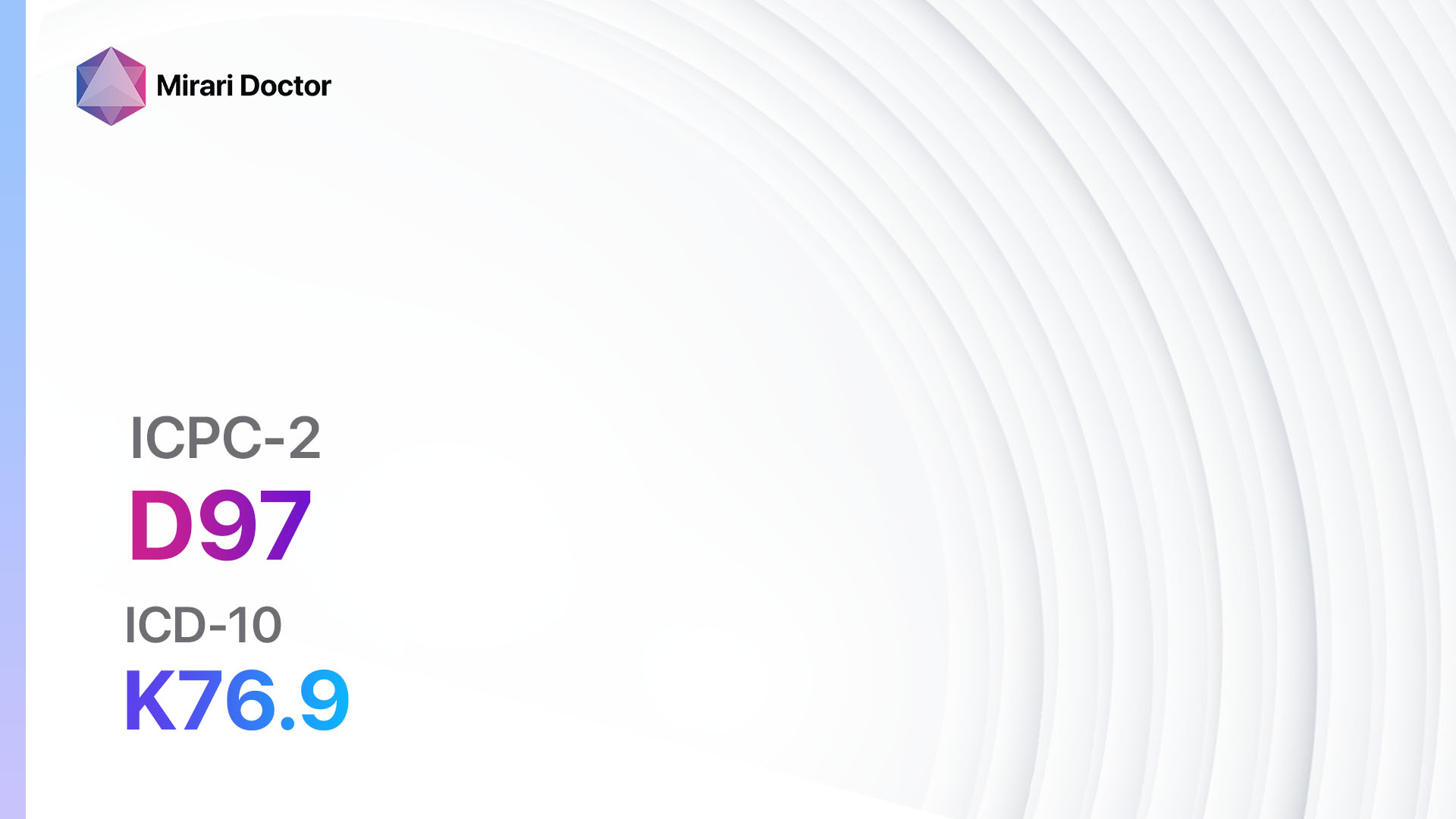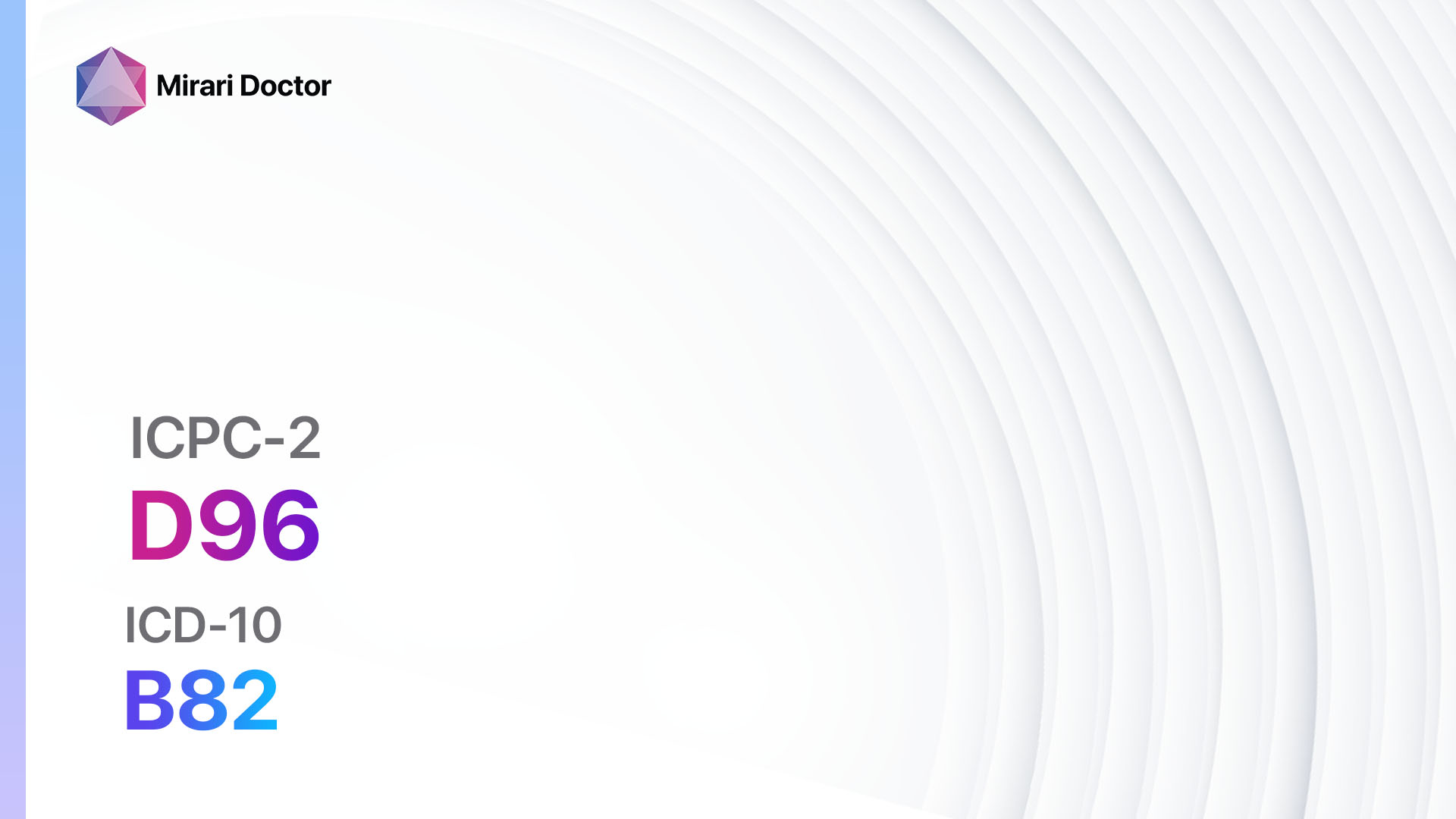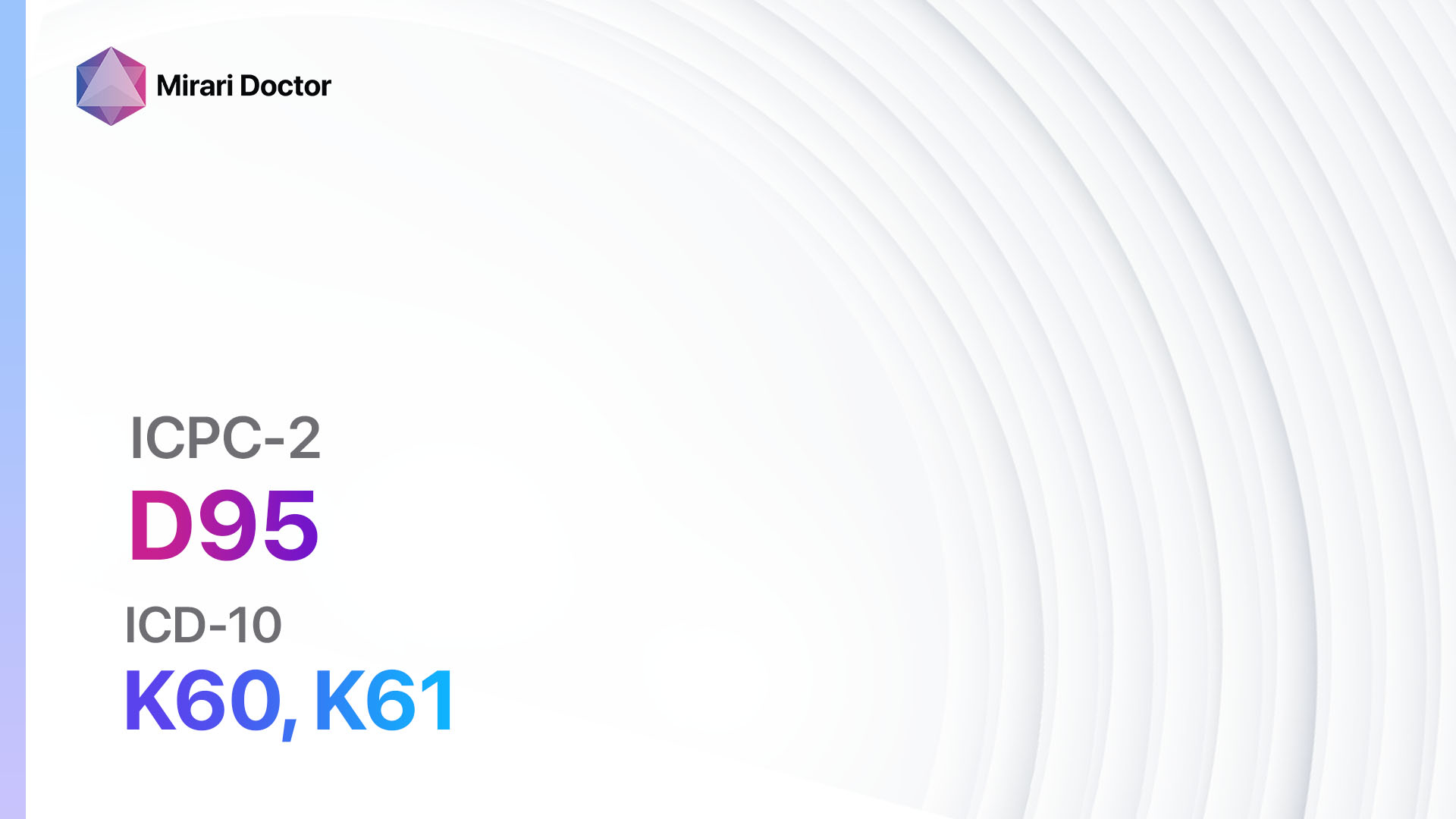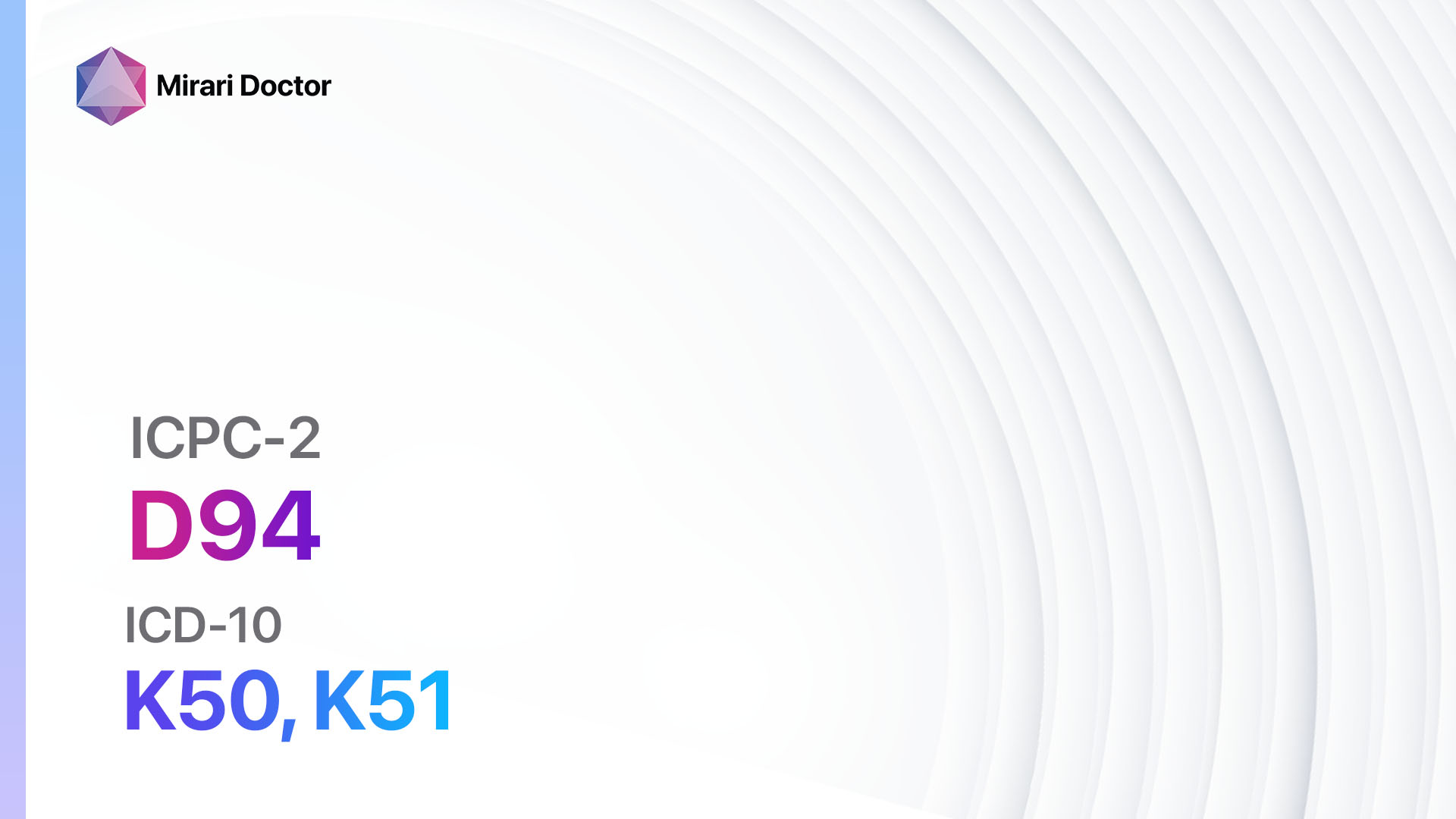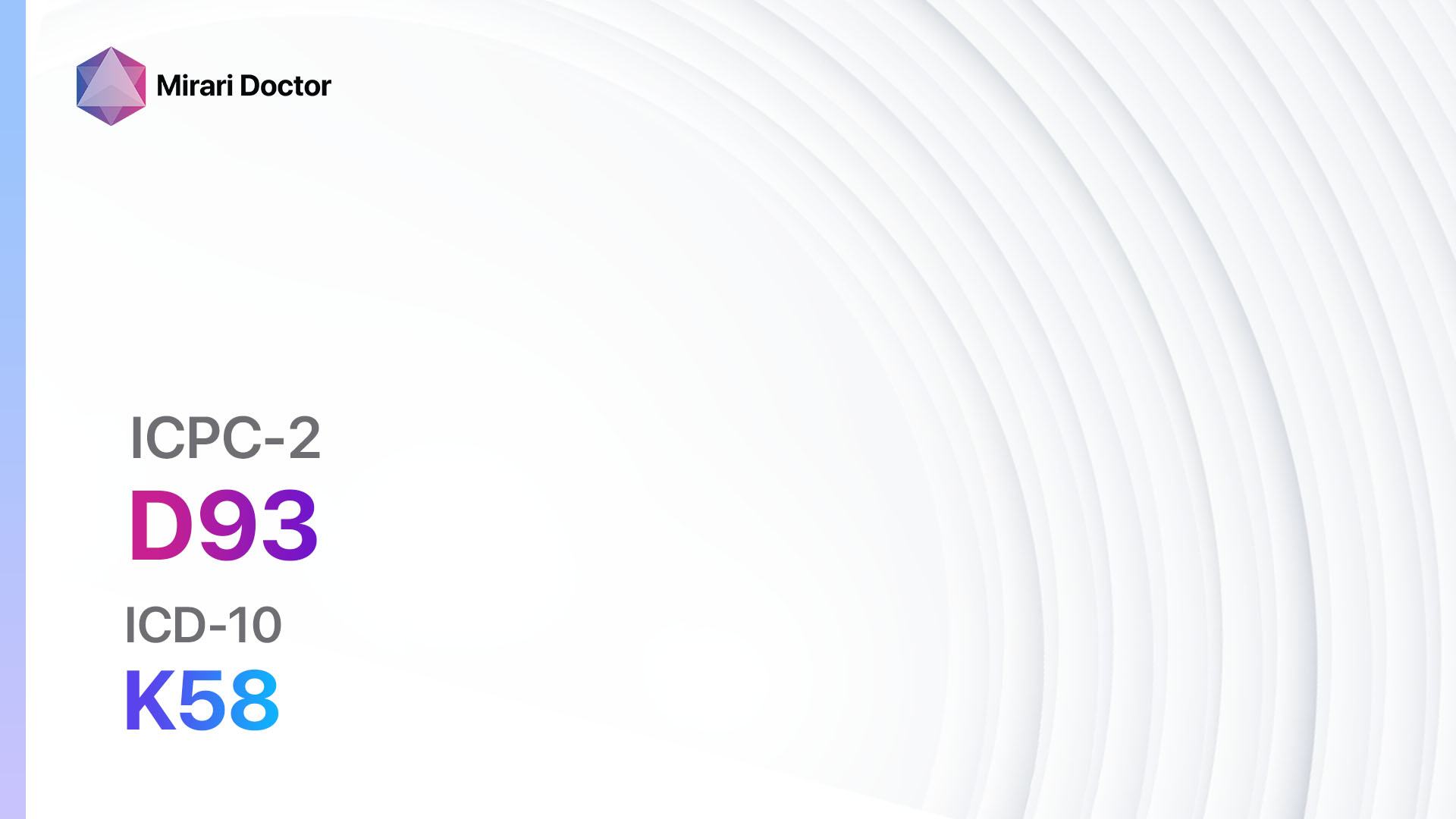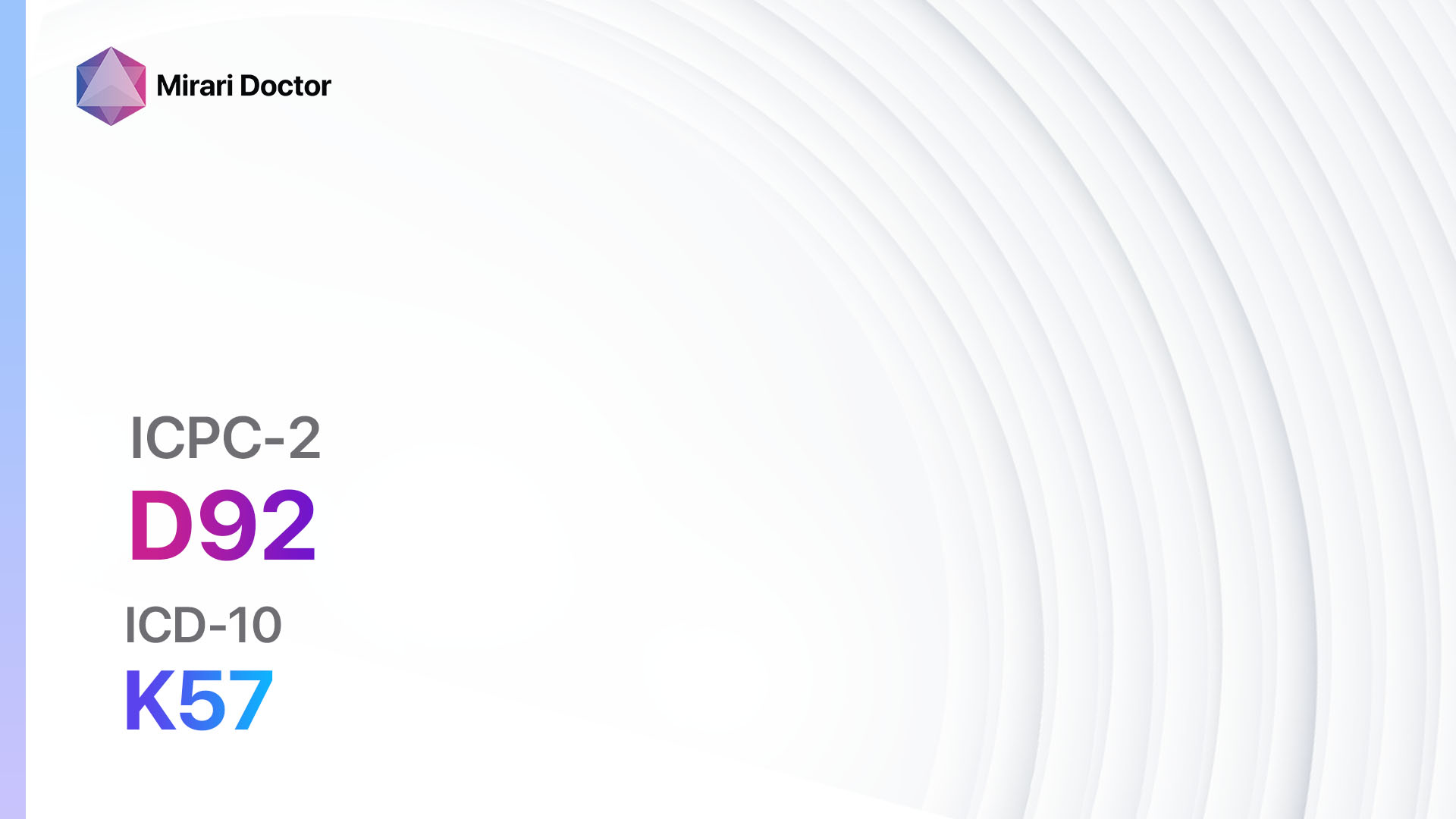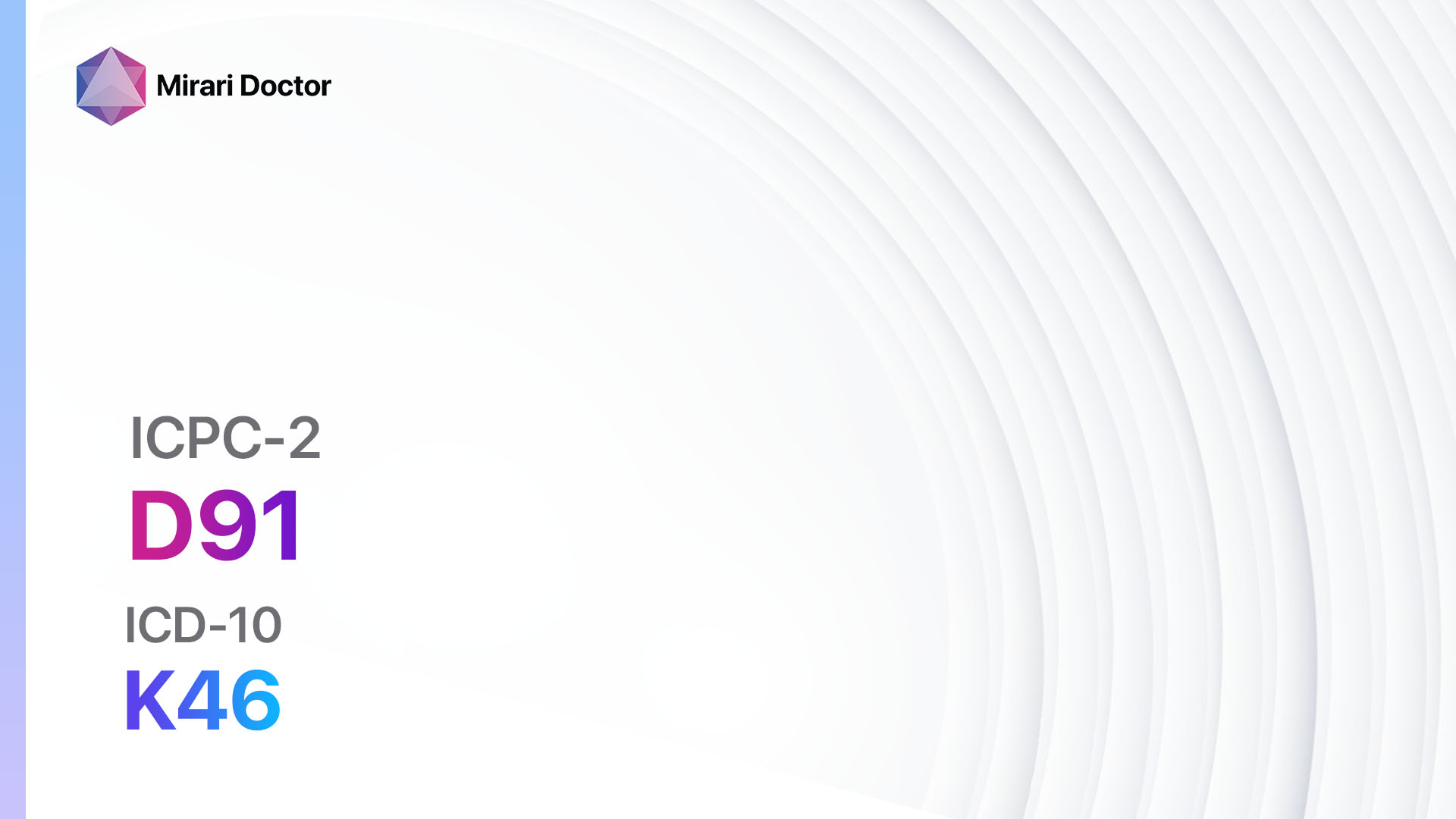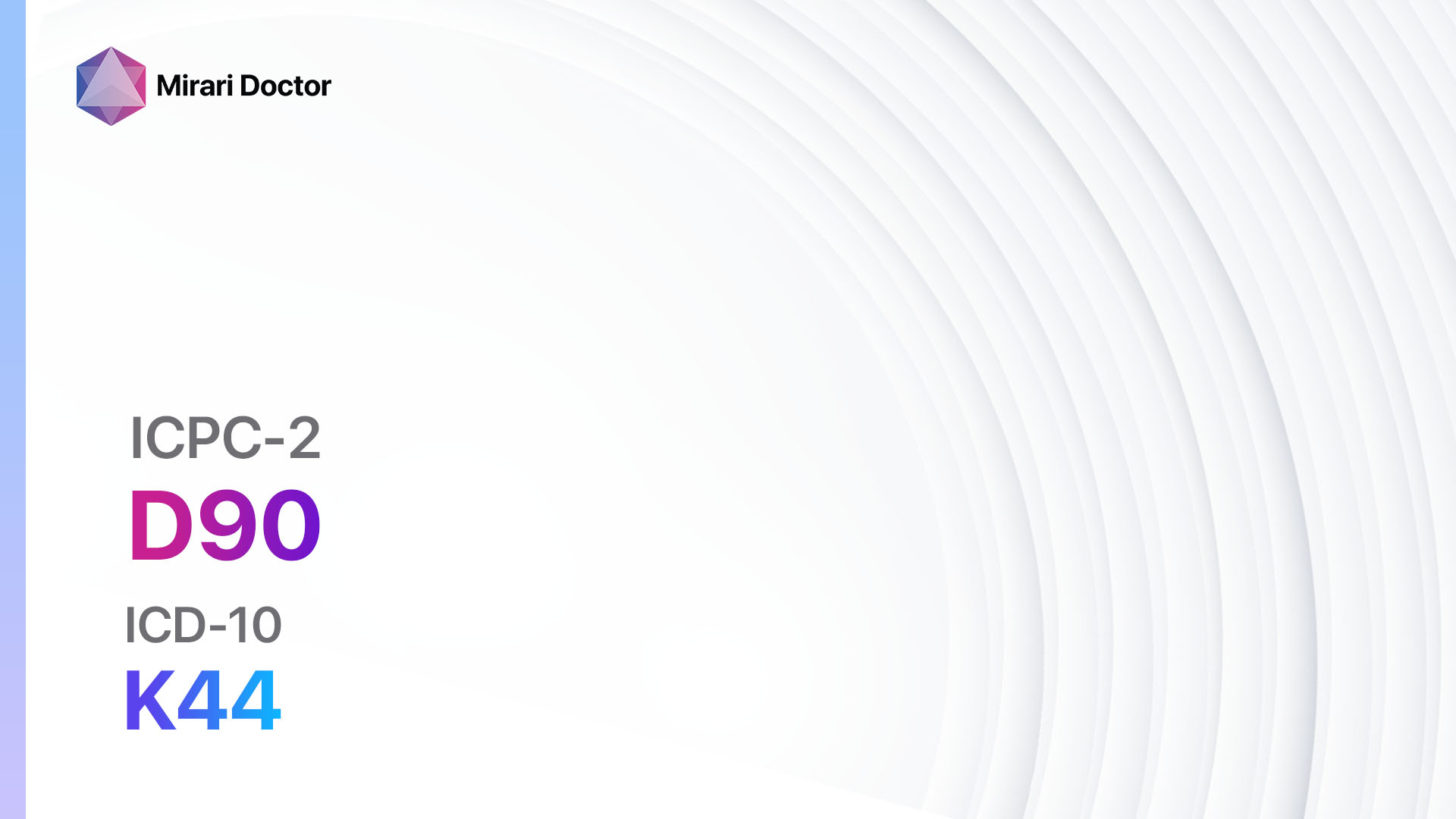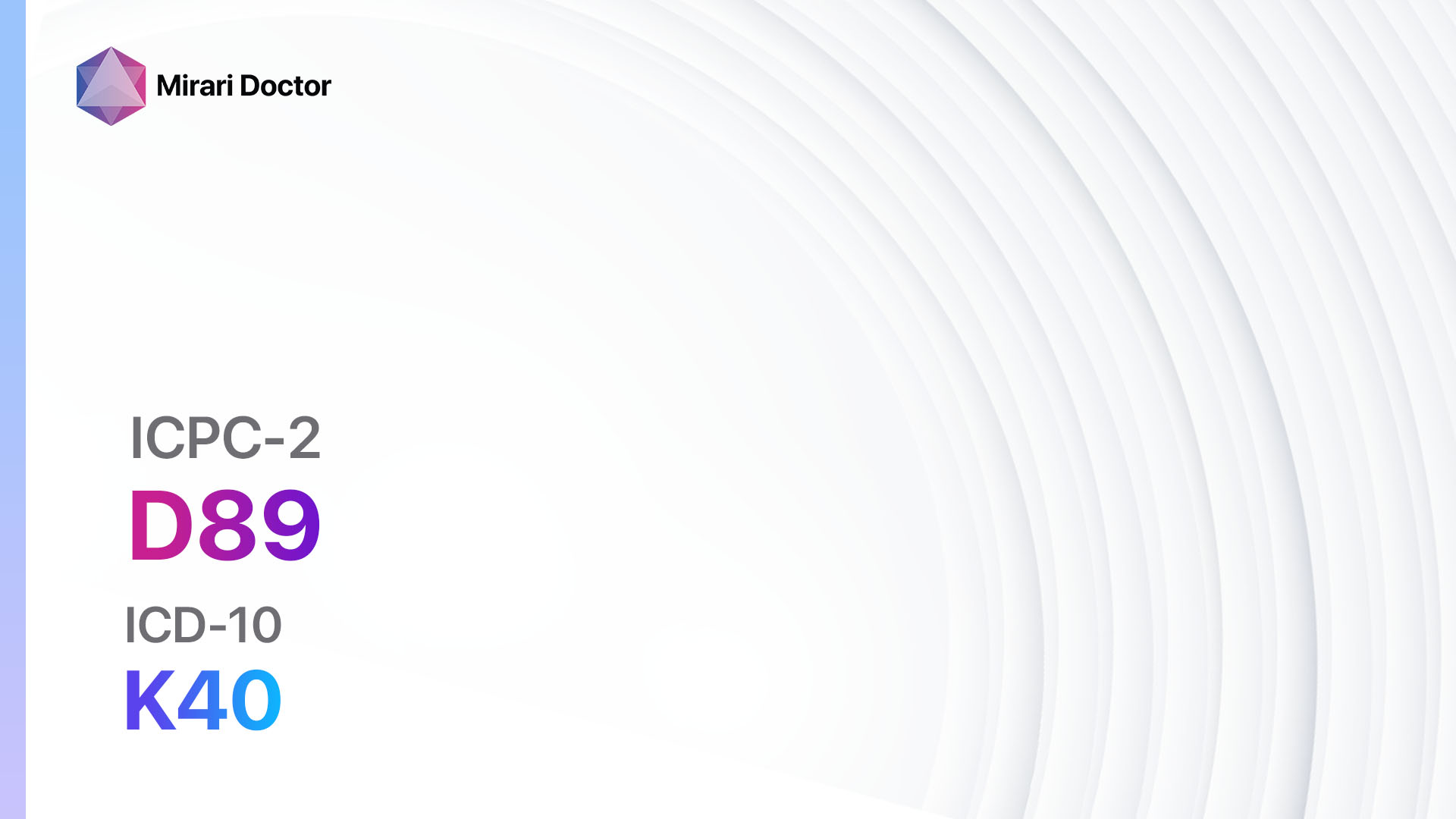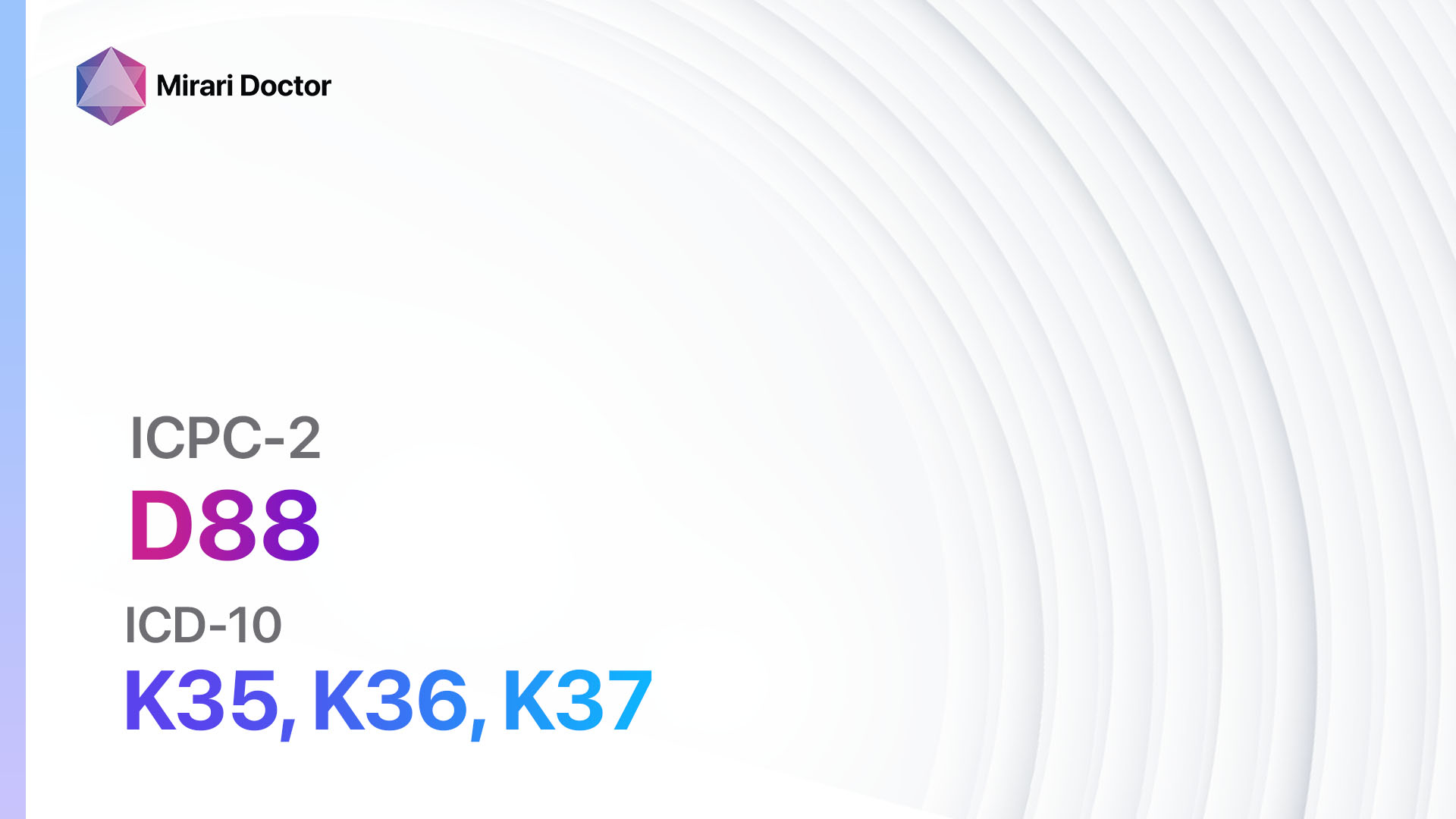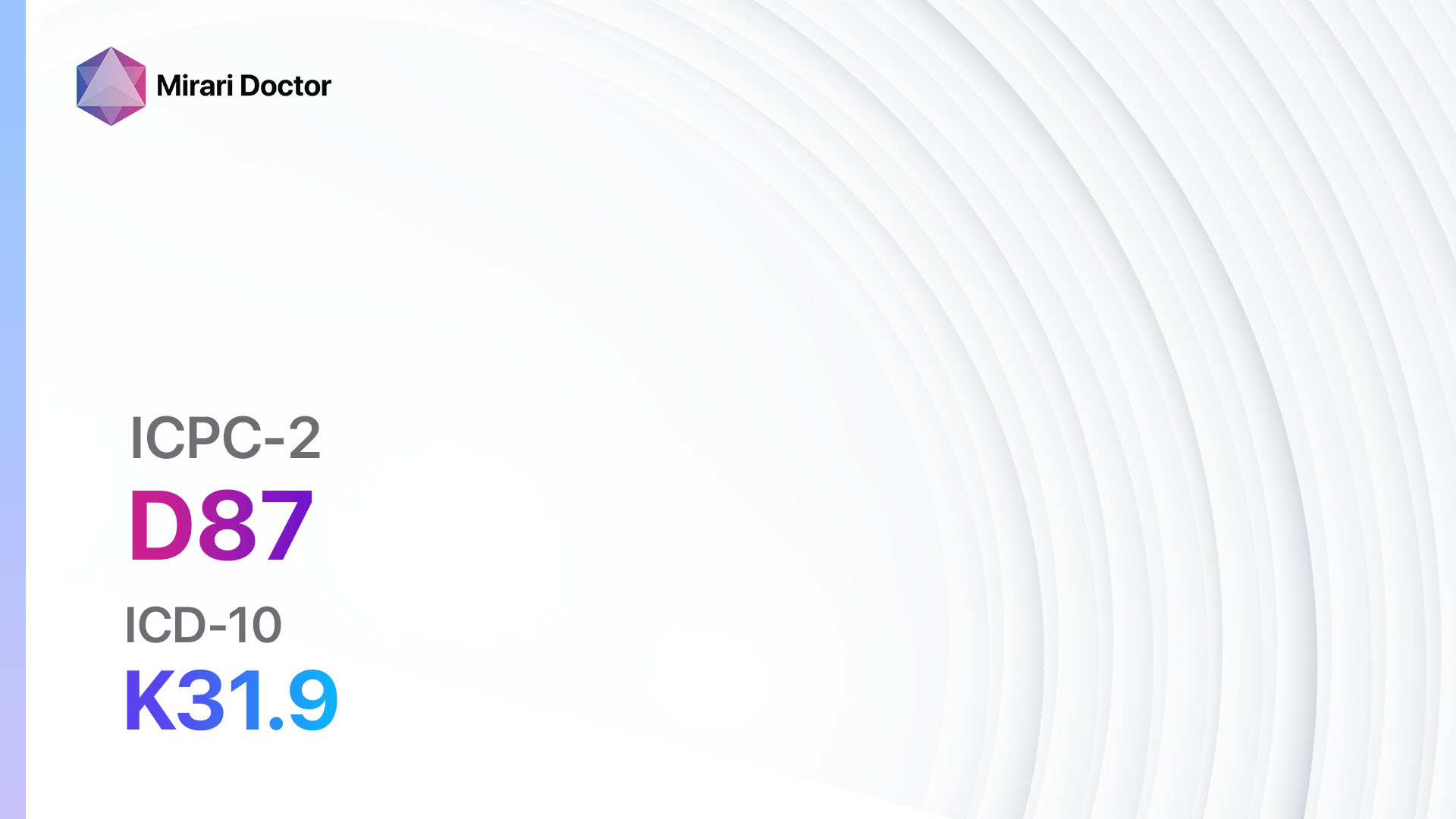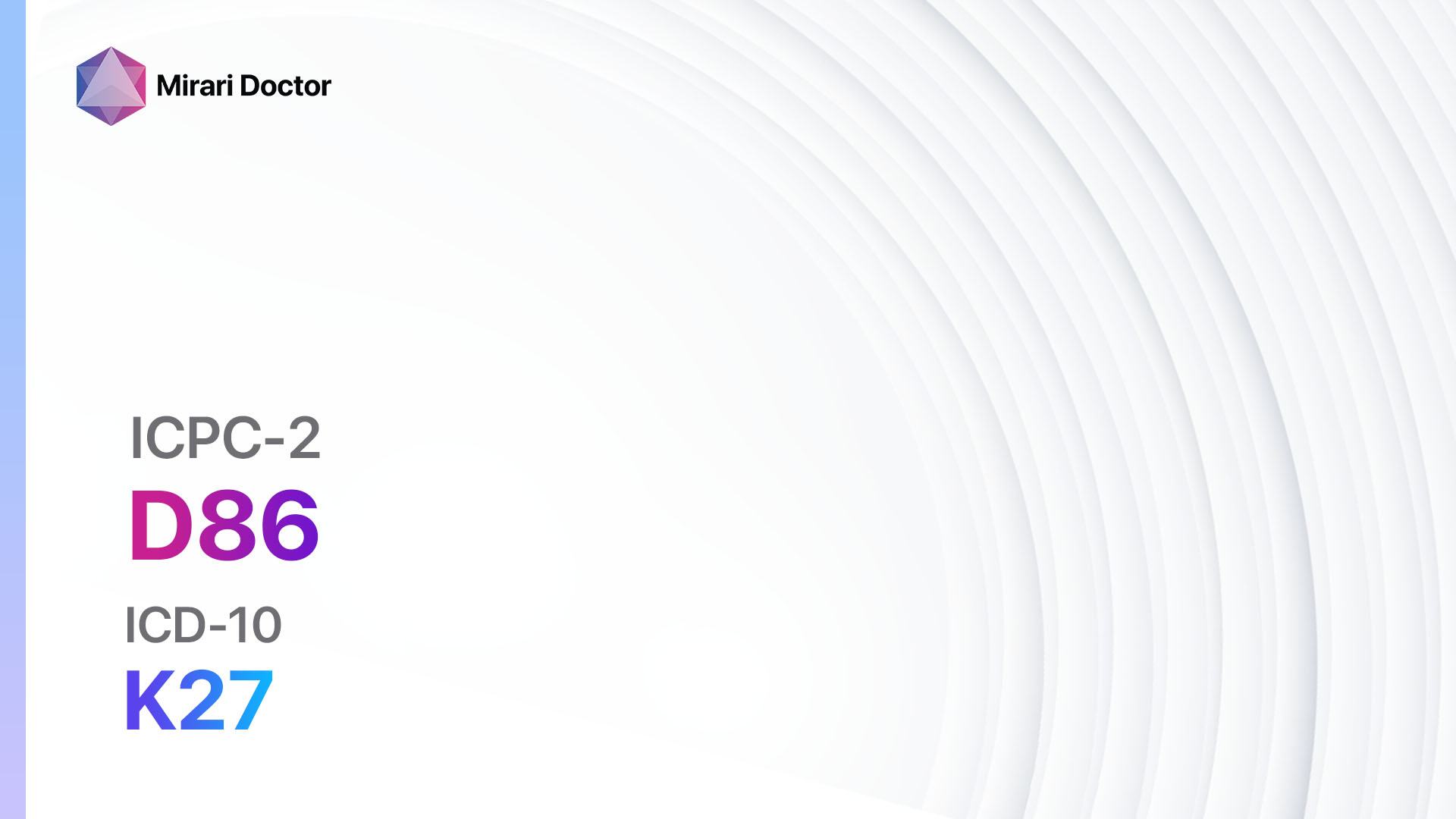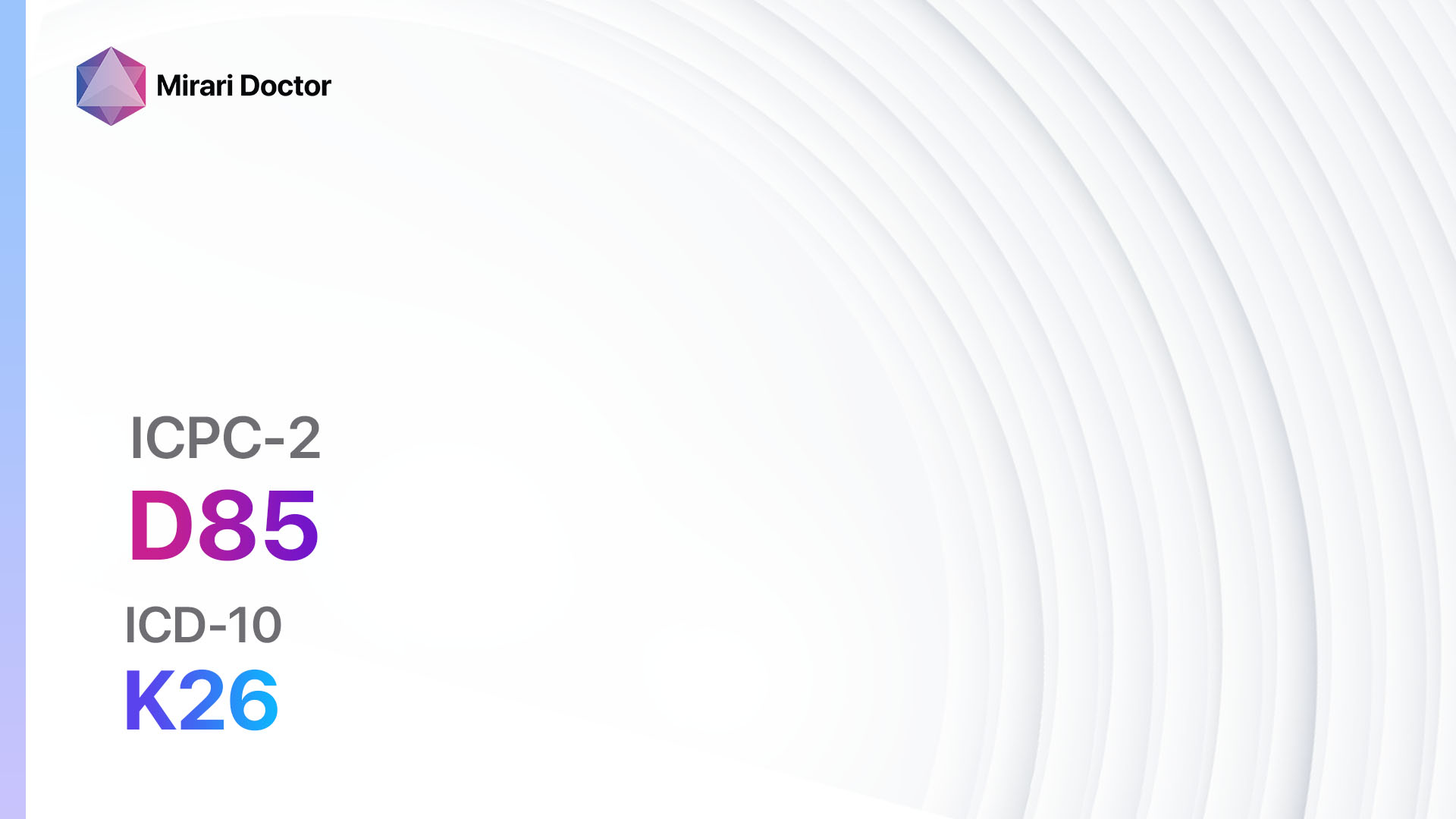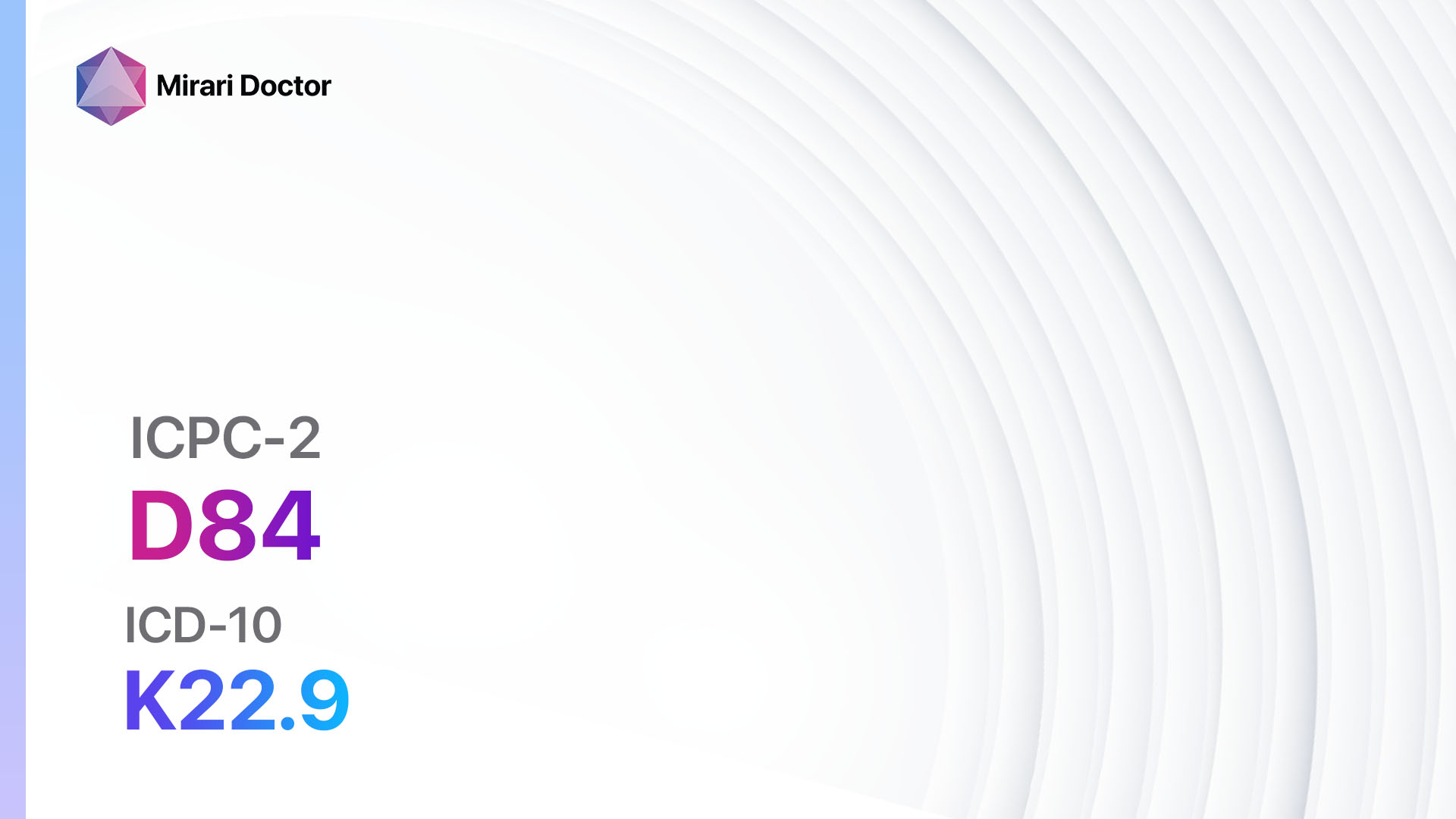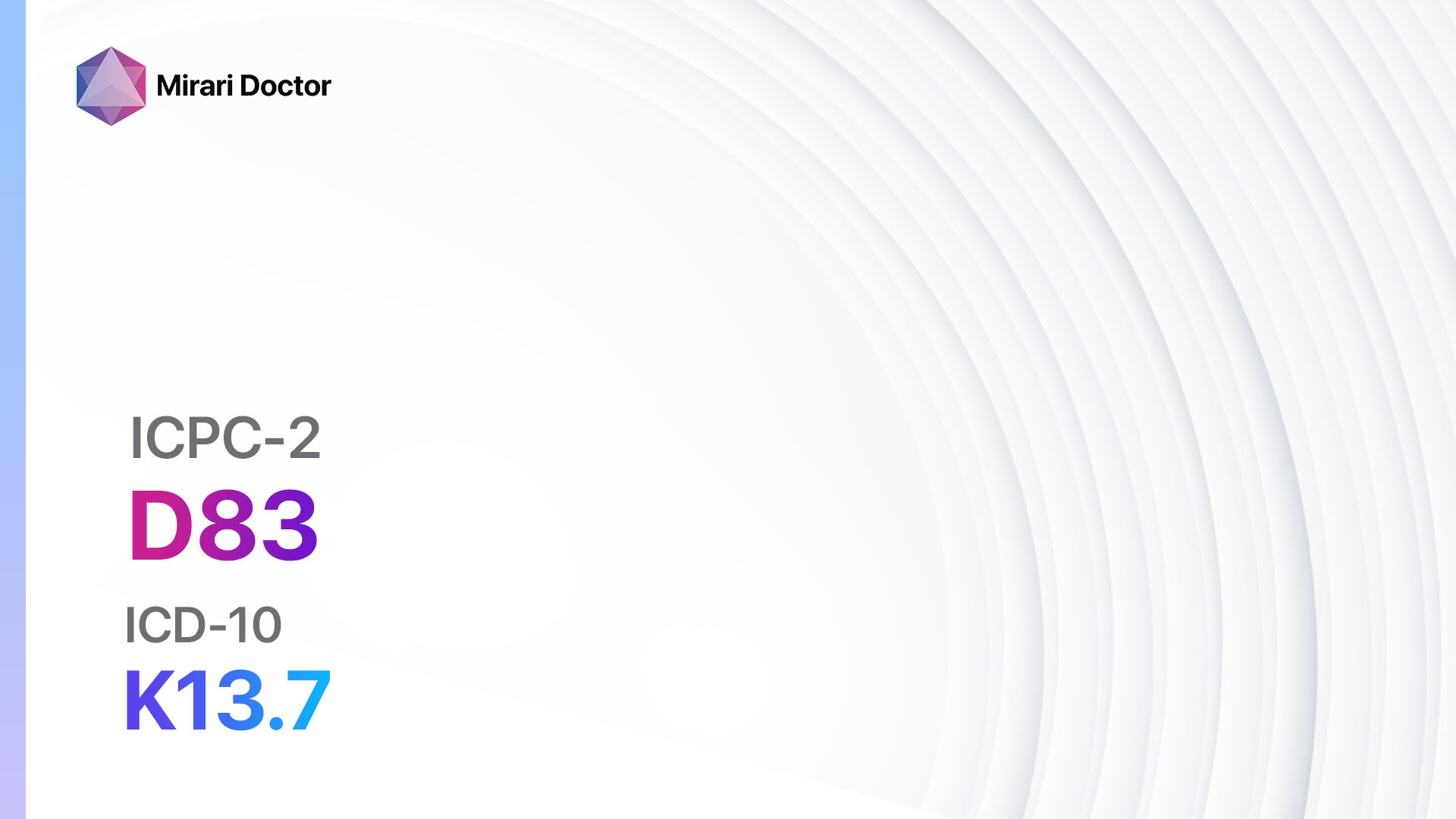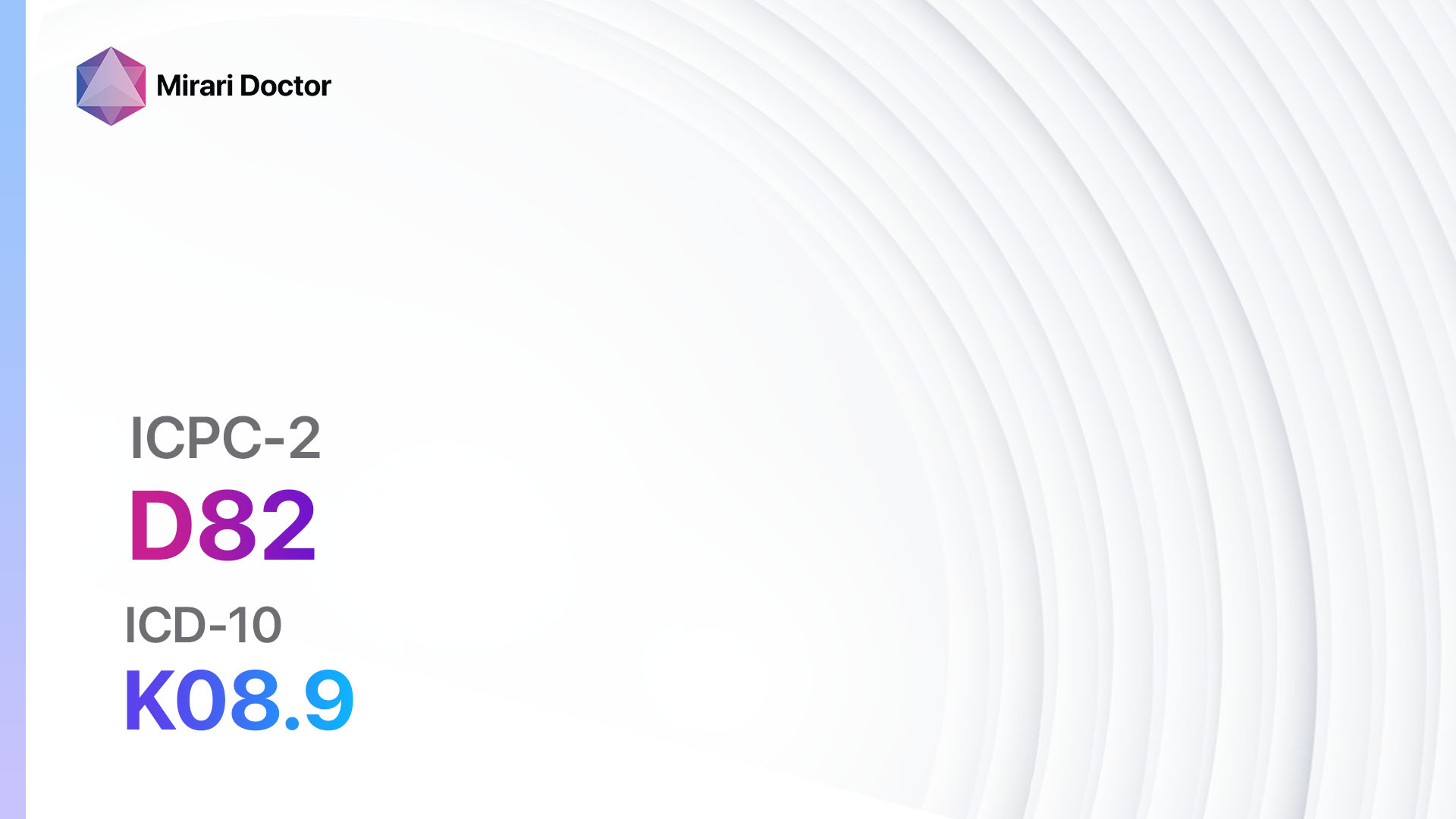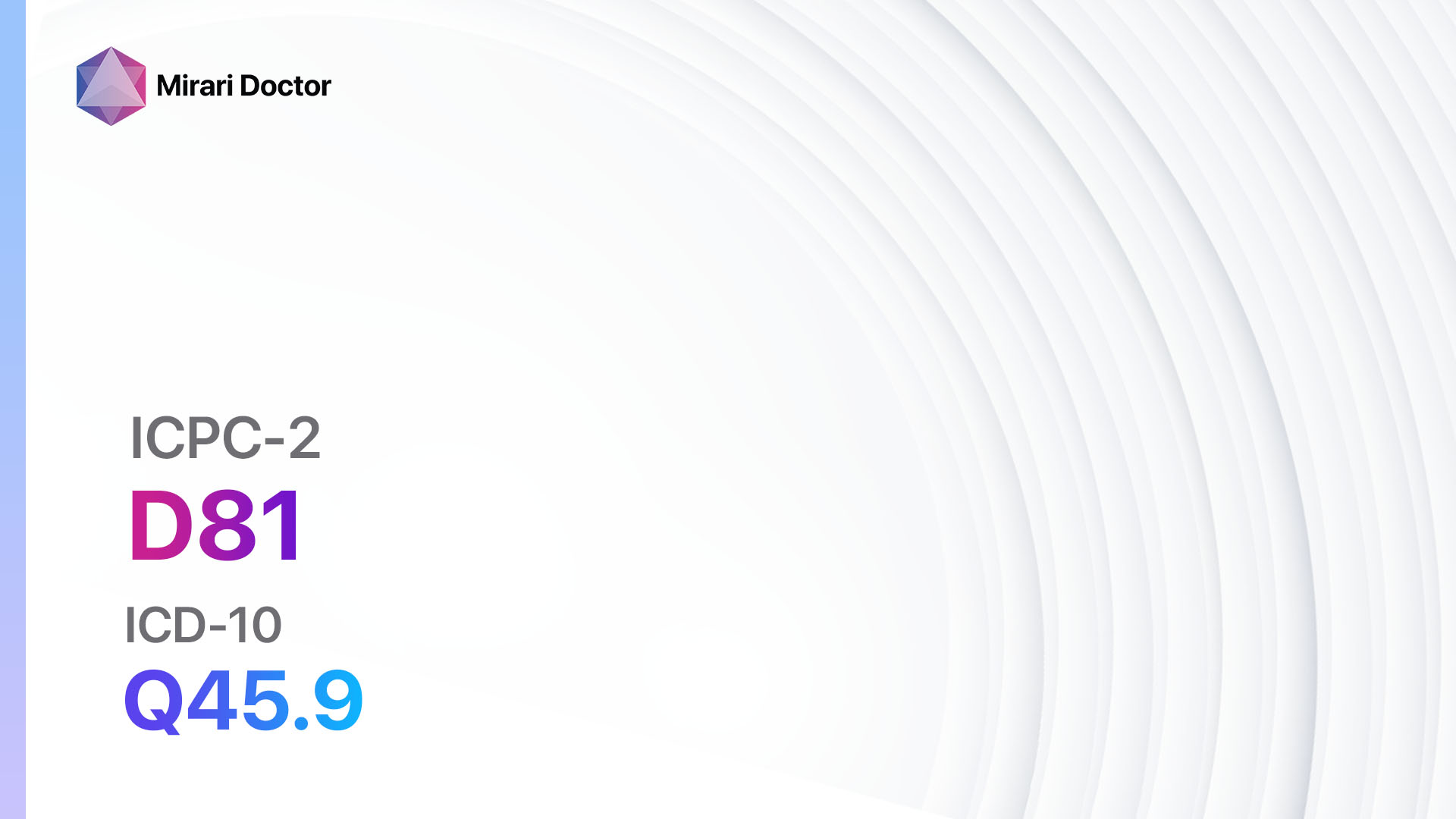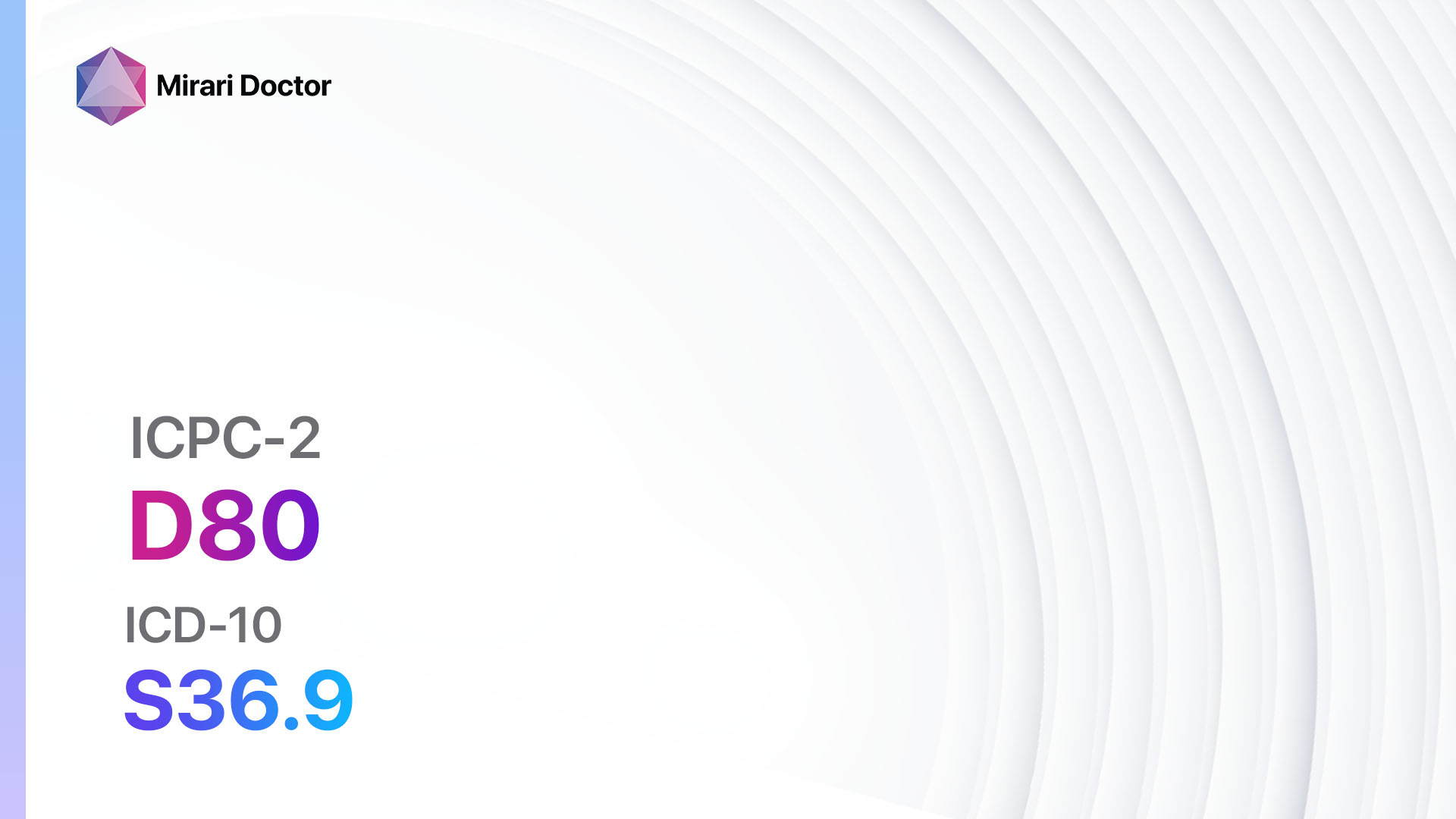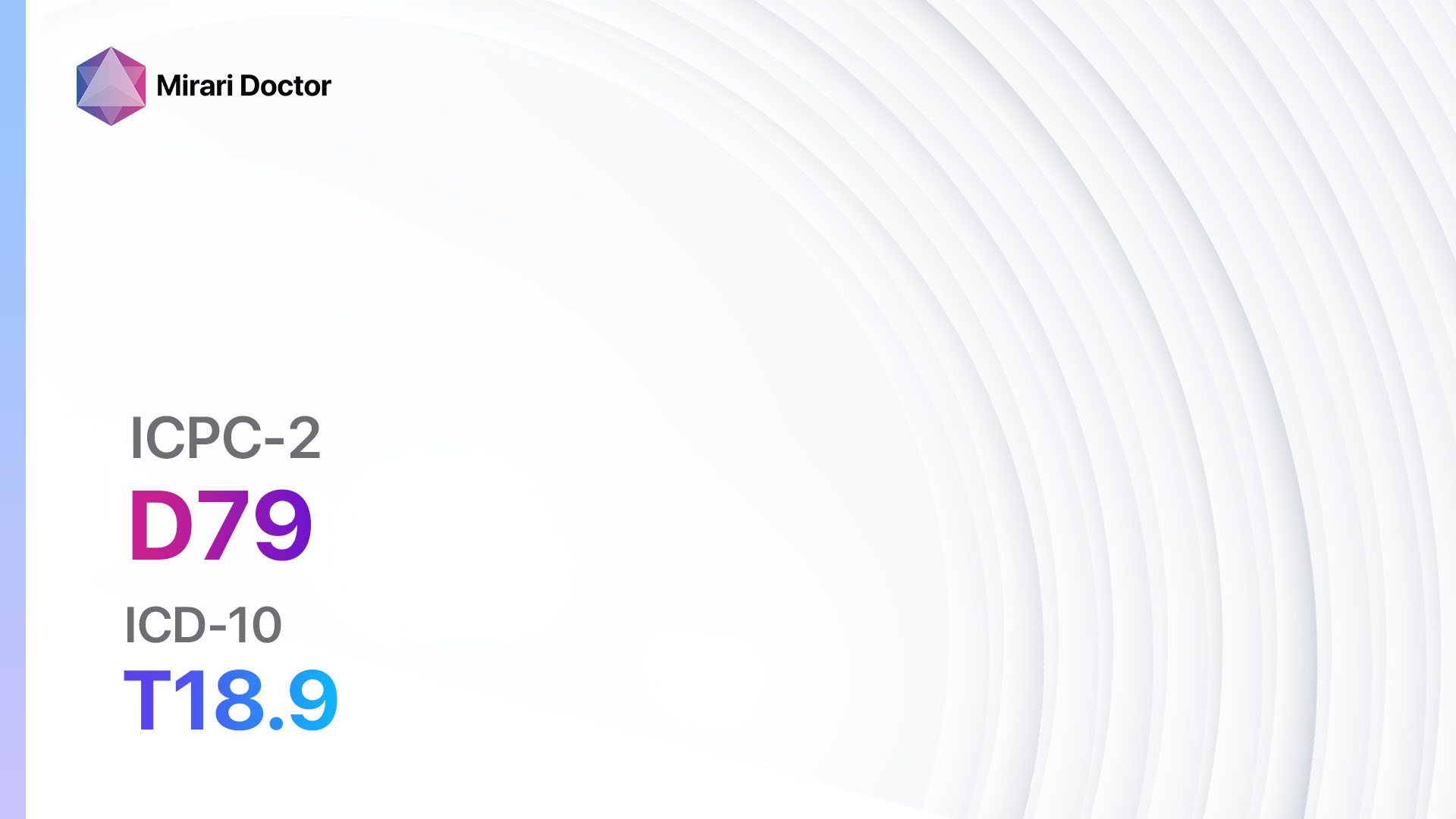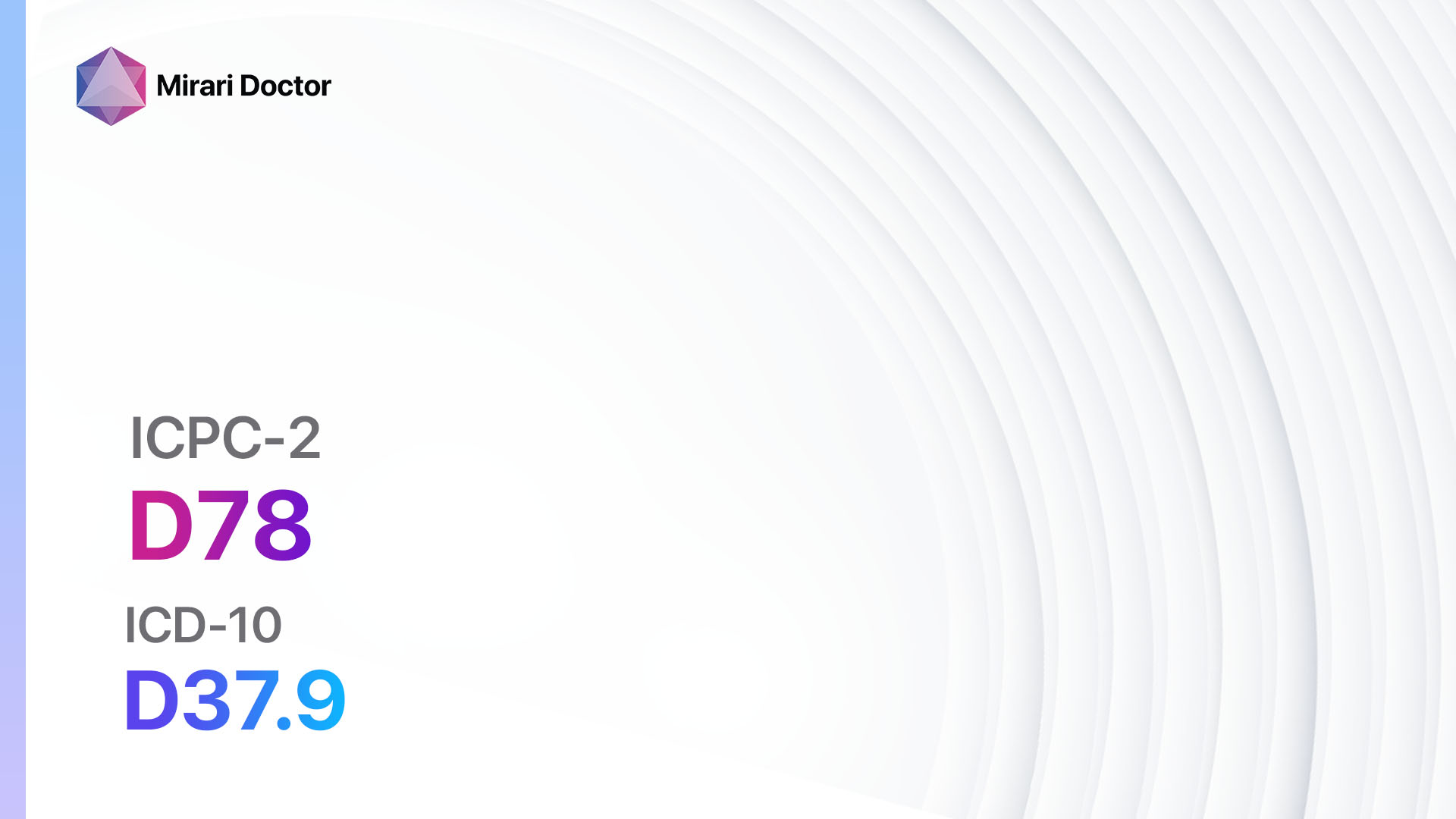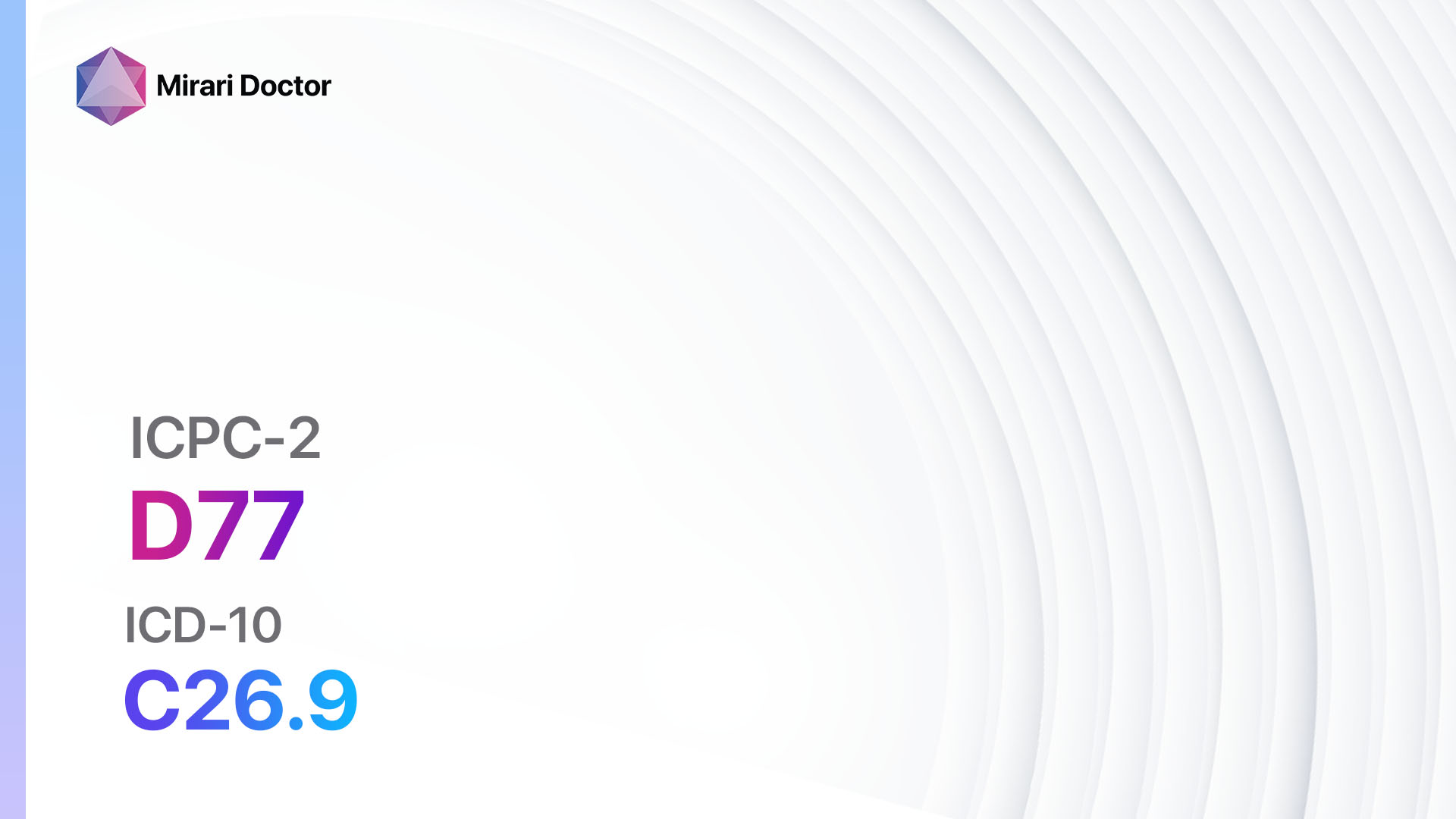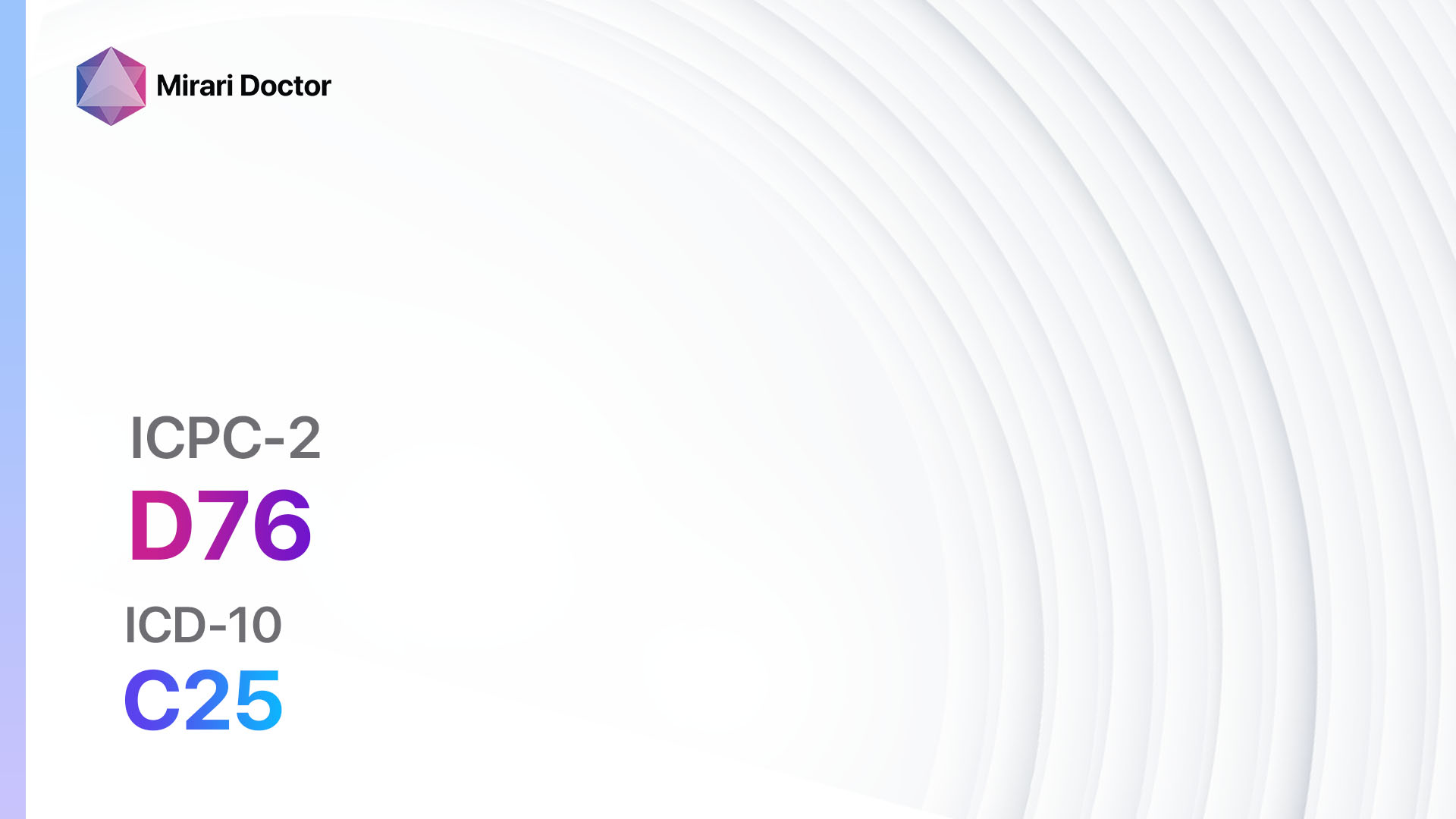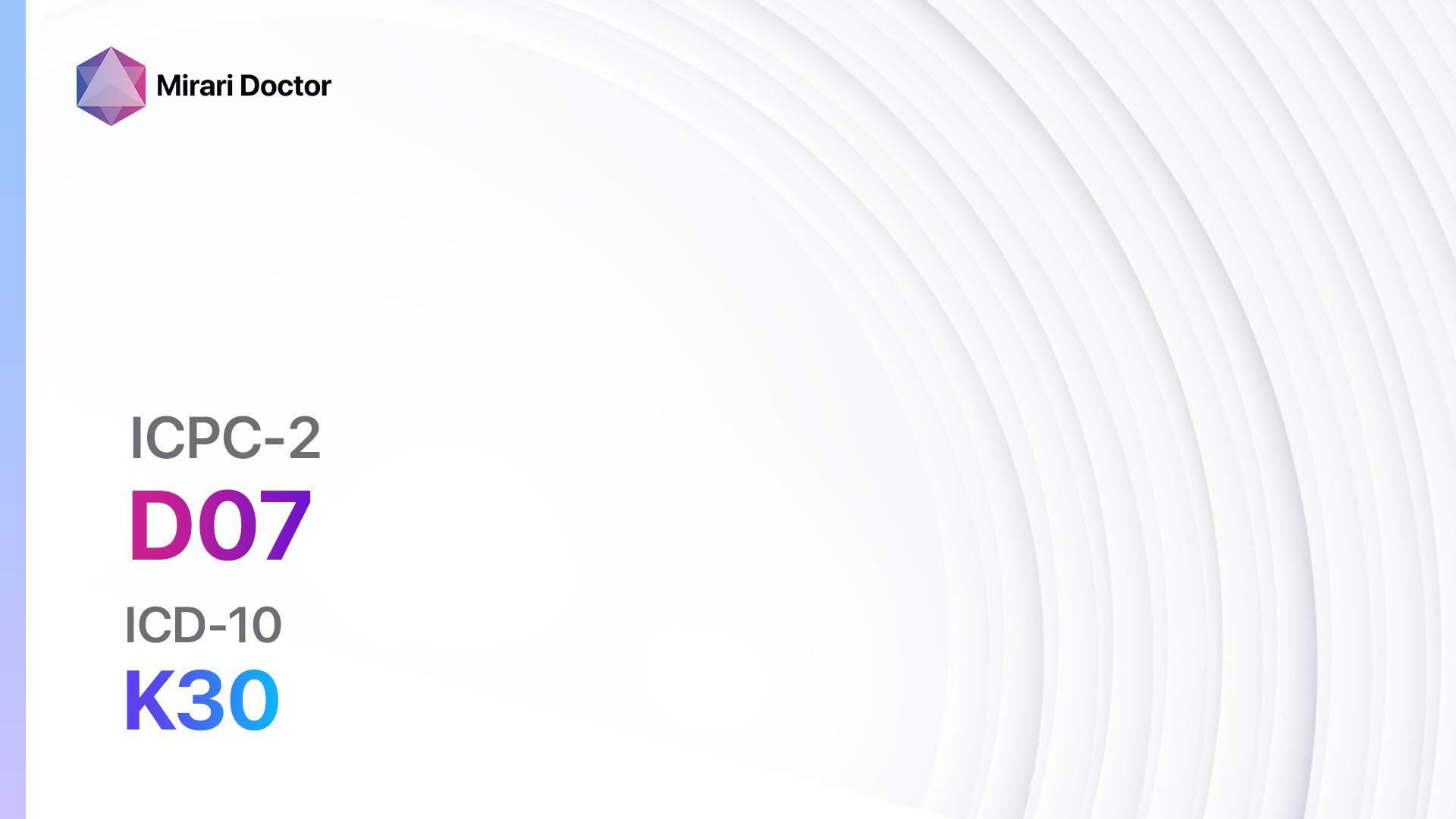
Introduction
Dyspepsia, also known as indigestion, is a common condition characterized by discomfort or pain in the upper abdomen. It can be caused by various factors, including lifestyle choices, diet, and underlying medical conditions[1]. The aim of this guide is to provide a comprehensive overview of dyspepsia, including its symptoms, causes, diagnostic steps, possible interventions, and patient education.
Codes
Symptoms
- Abdominal pain or discomfort[2]
- Bloating[3]
- Nausea[4]
- Belching[5]
- Heartburn[6]
- Loss of appetite[7]
- Early satiety[8]
Causes
- Overeating or eating too quickly[9]
- Consuming fatty, greasy, or spicy foods[10]
- Excessive alcohol consumption
- Smoking
- Stress or anxiety
- Gastroesophageal reflux disease (GERD)
- Peptic ulcers
- Gastritis
- Gallstones
- Pancreatitis
Diagnostic Steps
Medical History
- Gather information about the patient’s eating habits, including portion sizes and frequency of meals.
- Ask about the patient’s dietary choices, such as consumption of fatty or spicy foods.
- Inquire about the patient’s alcohol and tobacco use.
- Assess the patient’s stress levels and any recent life events that may have contributed to their symptoms.
- Determine if the patient has a history of GERD, peptic ulcers, gallstones, or pancreatitis.
Physical Examination
- Perform a thorough abdominal examination to assess for tenderness, distention, or abnormal masses.
- Check for signs of jaundice, which may indicate gallbladder or liver involvement.
- Evaluate the patient’s overall appearance and vital signs to assess for signs of dehydration or weight loss.
Laboratory Tests
- Complete blood count (CBC) to check for anemia or infection.
- Liver function tests to assess liver health and rule out liver disease.
- Amylase and lipase levels to evaluate pancreatic function.
- pylori testing to determine if the bacteria is present in the stomach, which can cause gastritis or peptic ulcers.
Diagnostic Imaging
- Upper gastrointestinal (GI) endoscopy to visualize the esophagus, stomach, and duodenum for any abnormalities.
- Abdominal ultrasound to assess the gallbladder, liver, and pancreas for any structural issues or abnormalities.
- Barium swallow or upper GI series to evaluate the function and structure of the esophagus and stomach.
Other Tests
- Gastric emptying study to assess the rate at which food leaves the stomach.
- pH monitoring to measure the acidity levels in the esophagus and determine if acid reflux is contributing to symptoms.
- Breath test to detect the presence of small intestinal bacterial overgrowth (SIBO).
Follow-up and Patient Education
- Schedule a follow-up appointment to discuss the results of diagnostic tests and determine the appropriate treatment plan.
- Educate the patient about lifestyle modifications, such as avoiding trigger foods, eating smaller meals, and managing stress.
- Provide information on over-the-counter antacids and acid reducers that can help alleviate symptoms.
- Discuss the importance of maintaining a healthy weight, exercising regularly, and quitting smoking if applicable.
- Emphasize the need for regular follow-up appointments to monitor symptoms and adjust treatment as necessary.
Possible Interventions
Traditional Interventions
Medications:
Top 5 drugs for Dyspepsia/Indigestion:
- Antacids (e.g., Tums, Rolaids):
- Cost: $3-$10 for a bottle of 60-100 tablets.
- Contraindications: Allergy to antacids.
- Side effects: Constipation or diarrhea.
- Severe side effects: Rare, but can include kidney stones or electrolyte imbalances.
- Drug interactions: Some antacids can interfere with the absorption of other medications.
- Warning: Long-term use of antacids can mask underlying conditions and may require further evaluation.
- H2 blockers (e.g., Ranitidine, Famotidine):
- Cost: $10-$30 for a month’s supply.
- Contraindications: Allergy to H2 blockers.
- Side effects: Headache, dizziness, or diarrhea.
- Severe side effects: Rare, but can include liver problems or blood disorders.
- Drug interactions: Some H2 blockers can interact with other medications, such as anticoagulants.
- Warning: Long-term use of H2 blockers may require monitoring of kidney function.
- Proton pump inhibitors (PPIs) (e.g., Omeprazole, Esomeprazole):
- Cost: $20-$50 for a month’s supply.
- Contraindications: Allergy to PPIs.
- Side effects: Headache, nausea, or diarrhea.
- Severe side effects: Rare, but can include kidney problems or bone fractures.
- Drug interactions: PPIs can interact with certain medications, such as clopidogrel.
- Warning: Long-term use of PPIs may increase the risk of certain infections or nutrient deficiencies.
- Prokinetics (e.g., Metoclopramide, Domperidone):
- Cost: $10-$30 for a month’s supply.
- Contraindications: Allergy to prokinetics, gastrointestinal bleeding, or intestinal obstruction.
- Side effects: Drowsiness, restlessness, or diarrhea.
- Severe side effects: Rare, but can include movement disorders or neuroleptic malignant syndrome.
- Drug interactions: Prokinetics can interact with other medications, such as antipsychotics.
- Warning: Long-term use of prokinetics may require monitoring for side effects.
- Antibiotics (e.g., Amoxicillin, Clarithromycin):
- Cost: $10-$50 for a course of treatment.
- Contraindications: Allergy to antibiotics.
- Side effects: Nausea, diarrhea, or rash.
- Severe side effects: Rare, but can include severe allergic reactions or antibiotic-associated colitis.
- Drug interactions: Antibiotics can interact with other medications, such as oral contraceptives.
- Warning: Antibiotics should only be used if H. pylori infection is present and confirmed through testing.
Alternative Drugs:
- Herbal remedies (e.g., Ginger, Peppermint): Can help alleviate symptoms of dyspepsia and indigestion. Cost: Varies depending on the specific remedy.
- Digestive enzymes (e.g., Pancrelipase, Lactase): Can aid in the digestion of food and reduce symptoms. Cost: $10-$30 for a month’s supply.
- Probiotics (e.g., Lactobacillus, Bifidobacterium): Can help restore the balance of gut bacteria and improve digestion. Cost: $10-$30 for a month’s supply.
- Simethicone (e.g., Gas-X): Can relieve bloating and gas symptoms. Cost: $5-$15 for a bottle of 60-100 tablets.
- Pepto-Bismol (Bismuth subsalicylate): Can help relieve symptoms of indigestion and upset stomach. Cost: $5-$10 for a bottle of liquid or tablets.
Surgical Procedures:
In most cases, surgical intervention is not necessary for dyspepsia or indigestion. However, if an underlying condition, such as gallstones or peptic ulcers, is causing the symptoms, surgery may be required. The cost of surgical procedures can vary significantly depending on the specific procedure and location.
Alternative Interventions
- Acupuncture: May help alleviate symptoms of dyspepsia and indigestion by promoting relaxation and improving digestion. Cost: $60-$120 per session.
- Herbal supplements: Certain herbs, such as chamomile or licorice root, have been used traditionally to relieve symptoms of indigestion. Cost: Varies depending on the specific supplement.
- Mind-body techniques: Practices like yoga, meditation, or deep breathing exercises can help reduce stress and improve digestion. Cost: Varies depending on the specific practice.
- Dietary modifications: Avoiding trigger foods, such as fatty or spicy foods, and incorporating more fiber-rich foods can help alleviate symptoms. Cost: Varies depending on individual food choices.
- Stress management techniques: Engaging in activities like exercise, relaxation techniques, or therapy can help reduce stress and improve digestion. Cost: Varies depending on the specific technique or therapy.
Lifestyle Interventions
- Healthy eating habits: Encourage patients to eat smaller, more frequent meals and chew food thoroughly.
- Avoid trigger foods: Advise patients to avoid fatty, greasy, or spicy foods that may exacerbate symptoms.
- Reduce stress: Recommend stress management techniques, such as exercise, meditation, or engaging in hobbies.
- Quit smoking: Encourage patients to quit smoking, as it can worsen symptoms of dyspepsia and indigestion.
- Limit alcohol consumption: Advise patients to moderate their alcohol intake, as excessive alcohol can contribute to symptoms.
It is important to note that the cost ranges provided are approximate and may vary depending on the location and availability of the interventions.
Mirari Cold Plasma Alternative Intervention
Understanding Mirari Cold Plasma
- Safe and Non-Invasive Treatment: Mirari Cold Plasma is a safe and non-invasive treatment option for various skin conditions. It does not require incisions, minimizing the risk of scarring, bleeding, or tissue damage.
- Efficient Extraction of Foreign Bodies: Mirari Cold Plasma facilitates the removal of foreign bodies from the skin by degrading and dissociating organic matter, allowing easier access and extraction.
- Pain Reduction and Comfort: Mirari Cold Plasma has a local analgesic effect, providing pain relief during the treatment, making it more comfortable for the patient.
- Reduced Risk of Infection: Mirari Cold Plasma has antimicrobial properties, effectively killing bacteria and reducing the risk of infection.
- Accelerated Healing and Minimal Scarring: Mirari Cold Plasma stimulates wound healing and tissue regeneration, reducing healing time and minimizing the formation of scars.
Mirari Cold Plasma Prescription
Video instructions for using Mirari Cold Plasma Device – D07 Dyspepsia/indigestion (ICD-10:K30)
| Mild | Moderate | Severe |
| Mode setting: 1 (Infection) Location: 3 (Kidney, Liver & Spleen) Morning: 15 minutes, Evening: 15 minutes |
Mode setting: 1 (Infection) Location: 3 (Kidney, Liver & Spleen) Morning: 30 minutes, Lunch: 30 minutes, Evening: 30 minutes |
Mode setting: 1 (Infection) Location: 3 (Kidney, Liver & Spleen) Morning: 30 minutes, Lunch: 30 minutes, Evening: 30 minutes |
| Mode setting: 2 (Wound Healing) Location: 3 (Kidney, Liver & Spleen) Morning: 15 minutes, Evening: 15 minutes |
Mode setting: 2 (Wound Healing) Location: 3 (Kidney, Liver & Spleen) Morning: 30 minutes, Lunch: 30 minutes, Evening: 30 minutes |
Mode setting: 2 (Wound Healing) Location: 3 (Kidney, Liver & Spleen) Morning: 30 minutes, Lunch: 30 minutes, Evening: 30 minutes |
| Mode setting: 7 (Immunotherapy) Location: 1 (Sacrum) Morning: 15 minutes, Evening: 15 minutes |
Mode setting: 7 (Immunotherapy) Location: 1 (Sacrum) Morning: 30 minutes, Lunch: 30 minutes, Evening: 30 minutes |
Mode setting: 7 (Immunotherapy) Location: 1 (Sacrum) Morning: 30 minutes, Lunch: 30 minutes, Evening: 30 minutes |
| Total Morning: 45 minutes approx. $7.50 USD, Evening: 45 minutes approx. $7.50 USD |
Total Morning: 90 minutes approx. $15 USD, Lunch: 90 minutes approx. $15 USD, Evening: 90 minutes approx. $15 USD, |
Total Morning: 90 minutes approx. $15 USD, Lunch: 90 minutes approx. $15 USD, Evening: 90 minutes approx. $15 USD, |
| Usual treatment for 7-60 days approx. $105 USD – $900 USD | Usual treatment for 6-8 weeks approx. $1,890 USD – $2,520 USD |
Usual treatment for 3-6 months approx. $4,050 USD – $8,100 USD
|
 |
|
Use the Mirari Cold Plasma device to treat Dyspepsia/indigestion effectively.
WARNING: MIRARI COLD PLASMA IS DESIGNED FOR THE HUMAN BODY WITHOUT ANY ARTIFICIAL OR THIRD PARTY PRODUCTS. USE OF OTHER PRODUCTS IN COMBINATION WITH MIRARI COLD PLASMA MAY CAUSE UNPREDICTABLE EFFECTS, HARM OR INJURY. PLEASE CONSULT A MEDICAL PROFESSIONAL BEFORE COMBINING ANY OTHER PRODUCTS WITH USE OF MIRARI.
Step 1: Cleanse the Skin
- Start by cleaning the affected area of the skin with a gentle cleanser or mild soap and water. Gently pat the area dry with a clean towel.
Step 2: Prepare the Mirari Cold Plasma device
- Ensure that the Mirari Cold Plasma device is fully charged or has fresh batteries as per the manufacturer’s instructions. Make sure the device is clean and in good working condition.
- Switch on the Mirari device using the power button or by following the specific instructions provided with the device.
- Some Mirari devices may have adjustable settings for intensity or treatment duration. Follow the manufacturer’s instructions to select the appropriate settings based on your needs and the recommended guidelines.
Step 3: Apply the Device
- Place the Mirari device in direct contact with the affected area of the skin. Gently glide or hold the device over the skin surface, ensuring even coverage of the area experiencing.
- Slowly move the Mirari device in a circular motion or follow a specific pattern as indicated in the user manual. This helps ensure thorough treatment coverage.
Step 4: Monitor and Assess:
- Keep track of your progress and evaluate the effectiveness of the Mirari device in managing your Dyspepsia/indigestion. If you have any concerns or notice any adverse reactions, consult with your health care professional.
Note
This guide is for informational purposes only and should not replace the advice of a medical professional. Always consult with your healthcare provider or a qualified medical professional for personal advice, diagnosis, or treatment. Do not solely rely on the information presented here for decisions about your health. Use of this information is at your own risk. The authors of this guide, nor any associated entities or platforms, are not responsible for any potential adverse effects or outcomes based on the content.
Mirari Cold Plasma System Disclaimer
- Purpose: The Mirari Cold Plasma System is a Class 2 medical device designed for use by trained healthcare professionals. It is registered for use in Thailand and Vietnam. It is not intended for use outside of these locations.
- Informational Use: The content and information provided with the device are for educational and informational purposes only. They are not a substitute for professional medical advice or care.
- Variable Outcomes: While the device is approved for specific uses, individual outcomes can differ. We do not assert or guarantee specific medical outcomes.
- Consultation: Prior to utilizing the device or making decisions based on its content, it is essential to consult with a Certified Mirari Tele-Therapist and your medical healthcare provider regarding specific protocols.
- Liability: By using this device, users are acknowledging and accepting all potential risks. Neither the manufacturer nor the distributor will be held accountable for any adverse reactions, injuries, or damages stemming from its use.
- Geographical Availability: This device has received approval for designated purposes by the Thai and Vietnam FDA. As of now, outside of Thailand and Vietnam, the Mirari Cold Plasma System is not available for purchase or use.
References
- Talley, N. J., & Ford, A. C. (2015). Functional dyspepsia. New England Journal of Medicine, 373(19), 1853-1863.
- Tack, J., & Talley, N. J. (2013). Functional dyspepsia—symptoms, definitions and validity of the Rome III criteria. Nature Reviews Gastroenterology & Hepatology, 10(3), 134-141.
- Stanghellini, V., Chan, F. K., Hasler, W. L., Malagelada, J. R., Suzuki, H., Tack, J., & Talley, N. J. (2016). Gastroduodenal disorders. Gastroenterology, 150(6), 1380-1392.
- Drossman, D. A. (2016). Functional gastrointestinal disorders: history, pathophysiology, clinical features, and Rome IV. Gastroenterology, 150(6), 1262-1279.
- Vakil, N., Halling, K., Ohlsson, L., & Wernersson, B. (2013). Symptom overlap between postprandial distress and epigastric pain syndromes of the Rome III dyspepsia classification. The American journal of gastroenterology, 108(5), 767-774.
- Savarino, E., Marabotto, E., Zentilin, P., Furnari, M., Bodini, G., De Maria, C., … & Savarino, V. (2018). The added value of impedance-pH monitoring to Rome III criteria in distinguishing functional heartburn from non-erosive reflux disease. Digestive and Liver Disease, 50(6), 542-547.
- Madisch, A., Andresen, V., Enck, P., Labenz, J., Frieling, T., & Schemann, M. (2018). The diagnosis and treatment of functional dyspepsia. Deutsches Ärzteblatt International, 115(13), 222.
- Vanheel, H., Carbone, F., Valvekens, L., Simren, M., Tornblom, H., Vanuytsel, T., … & Tack, J. (2017). Pathophysiological abnormalities in functional dyspepsia subgroups according to the Rome III criteria. The American journal of gastroenterology, 112(1), 132-140.
- Feinle-Bisset, C., & Azpiroz, F. (2013). Dietary and lifestyle factors in functional dyspepsia. Nature reviews Gastroenterology & hepatology, 10(3), 150-157.
- Pilichiewicz, A. N., Horowitz, M., Holtmann, G. J., Talley, N. J., & Feinle–Bisset, C. (2009). Relationship between symptoms and dietary patterns in patients with functional dyspepsia. Clinical Gastroenterology and Hepatology, 7(3), 317-322.
Related articles
Made in USA


